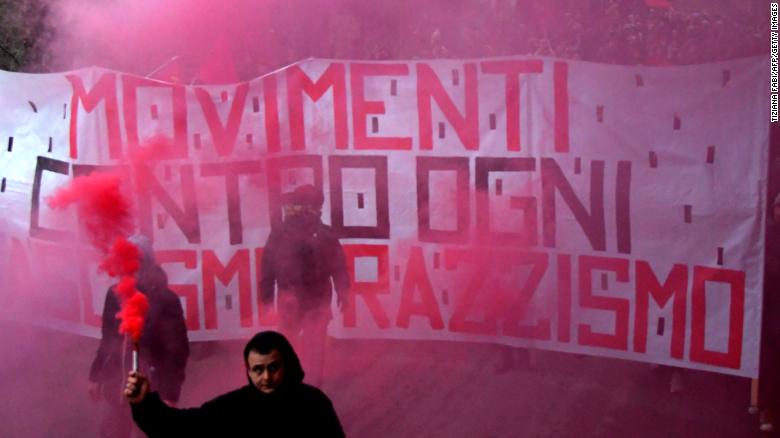
The interview was first published in Hungarian, on the Mérce.hu website.
Tensions between Rome and Brussels are going to increase, says Italian scholar Lorenzo Cini. The centrist populist Five Star Movement and the extreme right-wing League managed to replace the traditional mainstream parties, however aside from belligerent anti-EU and anti-migration rhetoric, their governance will not bring relief to Italians suffering from the effects of crisis and austerity.
I think I am transmitting the puzzlement of many people not familiar with Italian politics when I ask: what exactly is the Five Star Movement (M5S)? How would you define this amorphous political formation?
 You are right, the M5S represents a peculiar actor in the European political landscape. If I look around, I don’t find a similar political party in any of the European democracies. Perhaps only ANO in the Czech Republic exhibits some similarities with M5S, but since its inception ANO has been formally less horizontal and participatory than the M5S.
You are right, the M5S represents a peculiar actor in the European political landscape. If I look around, I don’t find a similar political party in any of the European democracies. Perhaps only ANO in the Czech Republic exhibits some similarities with M5S, but since its inception ANO has been formally less horizontal and participatory than the M5S.
I will look at two dimensions of party politics to describe what M5S looks like today: the organizational structure and the ideology/political orientation.
In terms of organizational structure, M5S has always brought with itself the original tension between a non-accountable centralized national leadership (Beppe Grillo with his Blog and Gianroberto Casaleggio with the control of the online platform for the “internet democracy” of the M5S) and the grass-roots movement of the meet-ups rooted at the city level, consisting of ordinary people gathering regularly to talk about politics and promote social and political initiatives locally.
Over the past 5 years, this tension has been gradually ‘solved’ with the domination of the center over the local branches. Even though the rhetoric of “internet democracy” still plays a role, it is now clear that the power and the main decisions of M5S are taken by an informal group of people (made up of a few leaders) at the national level. This was evident, for instance, in the process of formation of an “alliance” and then a government with the League of Matteo Salvini. The decision on forming a government with Salvini was taken by Luigi Di Maio (the candidate for Prime Minister) along with a few of his collaborators.
However, the most interesting feature of M5S is its political orientation or its ‘ideology.’ M5S has a paradoxical nature: its ideology is to have no ideology. There is some truth in this proposition. If you ask them where they would position themselves on the left-right axis, they would immediately reply that they are neither on the left nor on the right. Yet, from an analytical point of view, this is not correct.
More than being neither left nor right, M5S is both left and right. Most Italian observers and analysts tend to agree on this feature. Indeed, if you look at the party manifesto of M5S and at the public statements of its leaders, you will see that they put forward radical progressive proposals on socio-economic issues (such as the introduction of basic income for all) and very conservative, or even xenophobic, proposals on immigration. In this sense, I kind of agree with those observers that define M5S as a populist party of the center.
If you look at its electorate, you find that half of them are former voters of leftist parties, while the other half supported right parties. The political and electoral strength of M5S rests precisely on this mimetic capacity, being both of the left and the right. This feature has indeed allowed them to attract in the general elections of March 4 many voters from across the political spectrum. This is why, it seems to me, that the label of M5S as “populists of the center” is the most correct.
The other big winner of the March elections was the Lega which for the untrained eye seems much easier to grasp: a party of the extreme right. What is the story behind this party?
 The Lega seems easier to grasp than M5S, but it is not. First of all, and unlike M5S, Lega has a long political history. It dated back to mid-eighties when the first “leagues” (“leghe”) arose in Lombardy and Veneto (Northern Italy), to claim more fiscal and political autonomy from the central Italian state and from Rome. In the early 1990s, these small regional parties coalesced to form the Northern League (“Lega Nord”) under the leadership of Umberto Bossi, a political party rooted in Northern Italy aiming at implementing a political secession from the rest of Italy, which was accused of stealing the financial and economic resources of the productive Northern Italy. Adopting the classical sociological language of political cleavages, this conflict was understood as a “normal” center (Rome) – periphery (Northern Italy) cleavage. This cleavage has lasted and has been politically relevant for about twenty years, let’s say, until 2011 (until the aftermath of the economic crisis).
The Lega seems easier to grasp than M5S, but it is not. First of all, and unlike M5S, Lega has a long political history. It dated back to mid-eighties when the first “leagues” (“leghe”) arose in Lombardy and Veneto (Northern Italy), to claim more fiscal and political autonomy from the central Italian state and from Rome. In the early 1990s, these small regional parties coalesced to form the Northern League (“Lega Nord”) under the leadership of Umberto Bossi, a political party rooted in Northern Italy aiming at implementing a political secession from the rest of Italy, which was accused of stealing the financial and economic resources of the productive Northern Italy. Adopting the classical sociological language of political cleavages, this conflict was understood as a “normal” center (Rome) – periphery (Northern Italy) cleavage. This cleavage has lasted and has been politically relevant for about twenty years, let’s say, until 2011 (until the aftermath of the economic crisis).
However, between 2006 and 2011 the Northern League had been already facing an electoral decline. It was precisely in those years that a gradual, but inexorable political metamorphosis of the party started. Under the new leadership of the current leader Matteo Salvini (who is now Minister of the Interior), the party has undertaken a radical transformation, it has changed its political nature by modifying its main cleavage from the axis Northern Italy – Rome into that of Italians vs. migrants.
In other words, Salvini has succeeded in transforming the Norther League from a regional into a national (and now far right) party, the League, in order to capitalize on the social and economic problems experienced by the Italians after the crisis, and thus to attract new voters to relaunch the party. In this respect, the political slogan thanks to which Salvini won the last elections is very telling of this new political course: “Italians first!” (“Prima gli Italiani!”).
If you asked me to compare the new Lega with a political party in Western Europe, I would immediately say the National Front of Marine Le Pen. These parties are both national chauvinist and identify the European Union, on the one hand, and the migrants, on the other, as the actual political enemies of their societies, or more accurately, of their nations.
So, yes, the Lega by Matteo Salvini is now a “new” extreme right party – and also populist. Whereas M5S is a populist party of the center, Lega is a populist party of the right. These parties, together in government today, may be a lethal political cocktail.
Lethal political cocktail?
It will be particularly explosive in the migration issue, and in the already deteriorating relations with the EU and its core member states (especially Germany and France). In this respect, I hope that some diplomatic conflict won’t erupt soon. I am afraid that we will discover it in these months.
How did M5S and the Lega find each other after the elections?
In my view, there are two converging reasons. Taking for granted that both M5S and Lega were the big winners of the last elections, I single out a technical and a political reason for their agreement.
The technical reason is the electoral law (the “Rosatellum”) and its translation pf votes into parliamentary seats. I won’t enter in technicalities here, I just say that there were only two alternative parliamentary majorities: one was a convergence between M5S and PD, while the other was M5S and Lega. There were no other potential majorities in the Italian parliament (in terms of seats). The third option was new elections.
Here I come to the second, and more political, reason. Why a convergence between M5S and Lega and not between M5S and PD? Well, even though some Italian observers claimed that there were more similarities between the political manifestos of PD and M5S (in terms of civil rights, for instance), than between the manifestos of Lega and M5S, I believe that the “anti-establishment” ethos of both parties has played the role of political glue. It would have been difficult (and politically ridiculous) to imagine a coalition between a party which has implemented all the austerity measures of the past 5 years (the PD), and the M5S which has spent all these years in attacking the corruption (political and moral) of the old political elite (mostly identified with the PD itself), guilty of having sold Italy to the European Union and its banks. That’s why, for many people, the alliance between Lega and M5S was seen as the most natural and logical outcome of the 2018 elections.
M5S and Lega being the two winners of the elections, the mainstream parties are the losers. Is this collapse of the mainstream part of a broader continental trend or are there specifically Italian causes in the background?
Yes, I think that they are both true propositions. On the one hand, we have been witnessing a continental trend over the past 5-6 years (coinciding with the effects of the economic crisis) of collapse of the mainstream parties, namely, the parties which were more identified with the Troika and the austerity measures. In this sense, the Italian case doesn’t do exception. The decline of the PD is partially explainable through these lenses. The PD was seen as the pro-establishment party by definition.
On the other hand, we cannot deny that Italy represents an exception with its own peculiarities. Unlike Germany, Italy could not count on the productive levels of the manufacture industry; what is more, it did not undertake the process of technological innovation of its industries as Germany has been doing. This feature has impacted on the levels of economic growth, which are still below the standards of many European countries. It is then normal that Italian voters tended to punish the incumbent parties in the last elections.
However, in my view, the main peculiarity of the Italian case is still represented by the presence of the M5S, an anomalous party in the European landscape, which has conveyed over the last 5 year very anti-establishment messages. Italy, as in many cases in the past (see the rise of fascism), constitutes a sort of political laboratory of new political phenomena.
In what way will the newly elected government be different from its predecessors?
During the electoral campaign, both parties promised that if they would take power, Italy will no longer undergo any political diktat from the European Union, especially in fiscal and economic policies. The main political point of convergence between Lega and M5S on this was to retake the monetary sovereignty. I am not sure what kind of steps the Italian government will undertake to accomplish this. The Italexit may be an option, but at the moment I don’t see it as realistic. It is indeed becoming clear that not all the Lega “big” voters (especially some entrepreneurs in Northern Italy) would appreciate such choice. For sure, what the new government will try is a significant renegotiation of the Italian debt.
Will the Lega-M5S government have leverage to implement these decisions and oppose some decision of the EU? I am quite skeptical that this thing may happen. Both for the political inexperience of part of this coalition (especially the M5S) and for the structural financial weakness of Italy. Given our economic debt, it is difficult to be a strong political player with a credible threatening capacity in the EU.
Can we expect some kind of leftward turn at least in domestic social agenda?
No, I don’t think that we will see a leftward turn in the next months. As I mentioned above, the M5S had some progressive measure in its electoral manifesto. Most importantly, the introduction of the basic income. As we can see from these very first days of government, they are already reducing the scope and the radicality of this measure by transforming it into a mere unemployment benefit.

I am even more worried about the kind of fiscal policy that the government seems eager to adopt. There seems to be forming an agreement on the introduction of a flat tax. It is a type of fiscal measure that will generate more inequality among Italians. In practice it is the introduction of a reverse Robin Hood principle that steals from the poor people in order to give to the rich.
What is happening on the left? Any chance for a left-wing revival?
Well… let’s jump to the next question!
Jokes aside, this is by far the most difficult question that you can ask from an Italian political observer (with a progressive leaning). There are no plausible or meaningful answers to this question, frankly. We have abeen striving to understand why in a country with the strongest communist party in Western Europe in the second half of the 20thcentury, and the most powerful anti-globalization movement in Europe in the early 2000s, there is now the weakest left in Europe. I could give a list of non-exhaustive factors that have contributed to this picture.
One of them is the high political fragmentation of the political groups and parties on the left of PD. These parties are not only small, but they also have very divergent views that make an alliance impossible.
A related factor is the lack of a long-term political strategy that the leadership of these parties could follow. The main political goal is always to get people elected in the Italian parliament, rather than trying to reconnect with the people who in the past used to vote for Italian leftist parties. As the pursuit of this goal (being elected) has systematically been missed over the past 10 years, every national election there are always ‘new’ parties that compete. This does not create any feeling of trust between the parties and the voters.
If compared to other European left-wing initiatives (Labour in Britain, Syriza in Greece, or Podemos in Spain), the leaders of the fragmented Italian left are all but brave politicians, capable of adopting new political strategies to re-establish the Left.
Lorenzo Cini is currently a research fellow at the Institute of Humanities and Social Sciences of the Scuola Normale Superiore, Pisa. He received a PhD in Social and Political Sciences from the European University Institute in Florence, carrying out research into the contentious politics of higher education in Italy and England. Specifically, he investigated the range of university mobilizations that took place in England and Italy in opposition to recent neoliberal reforms in higher education. On this topic, he has published several articles (in Social Movement Studies, the Italian Review of Political Science, Anthropological Theoryand PACO) and contributions to edited volumes (for Brill and Routledge). His most recent publication is a monograph (The Contentious Politics of Higher Education. Struggles and Power Relations within Italian and English Universities) in Routledge’s Mobilization Series. Over the past five years, he has also carried out research in the field of political philosophy and theory, working on the concepts of democracy, justice and equality. On these topics, he recently published the book Civil Society and Radical Democracy(2012) and, in collaboration with Brunella Casalini, the volume Justice, Equality, and Difference. A Guide to the Reading of Contemporary Political Philosophy(2012).

